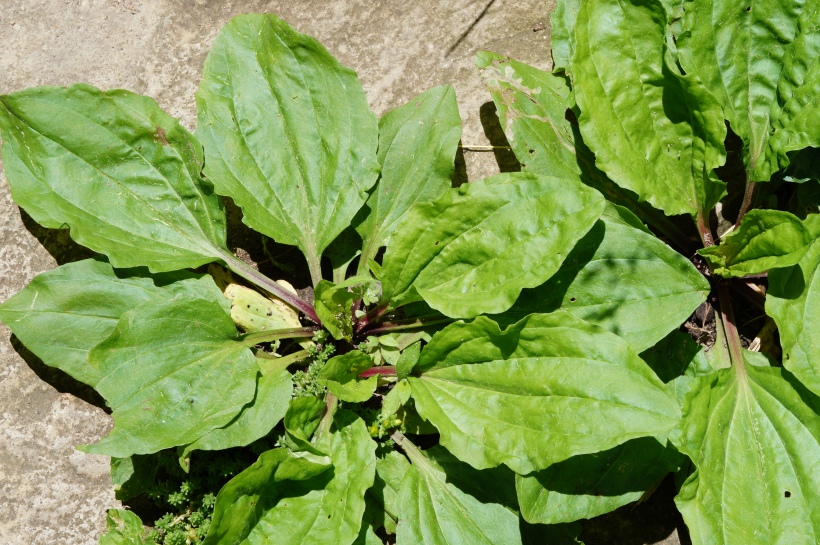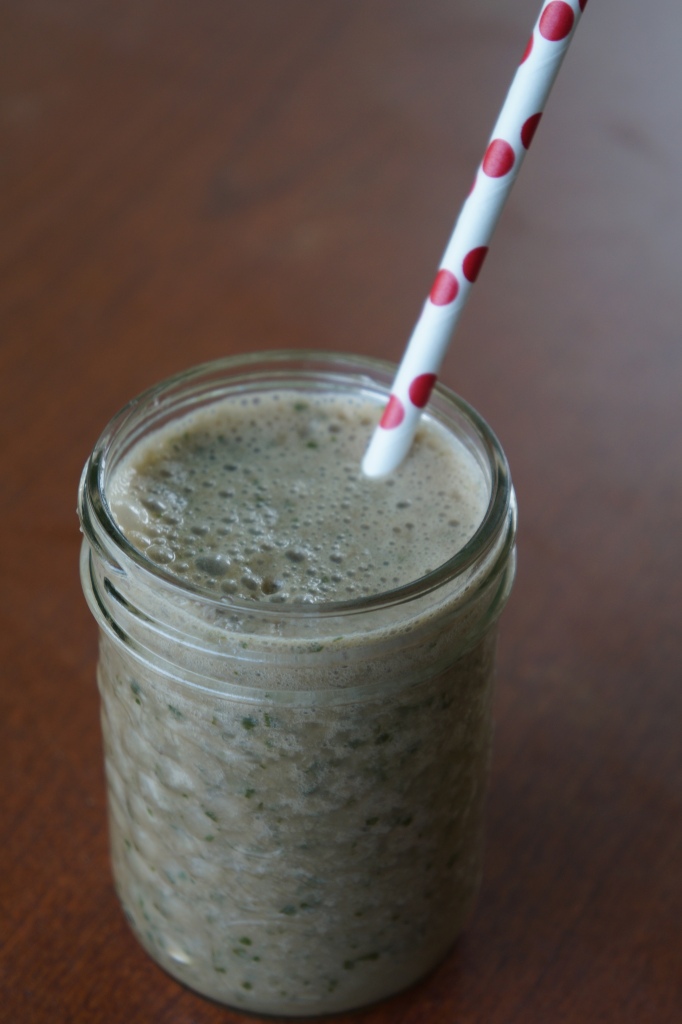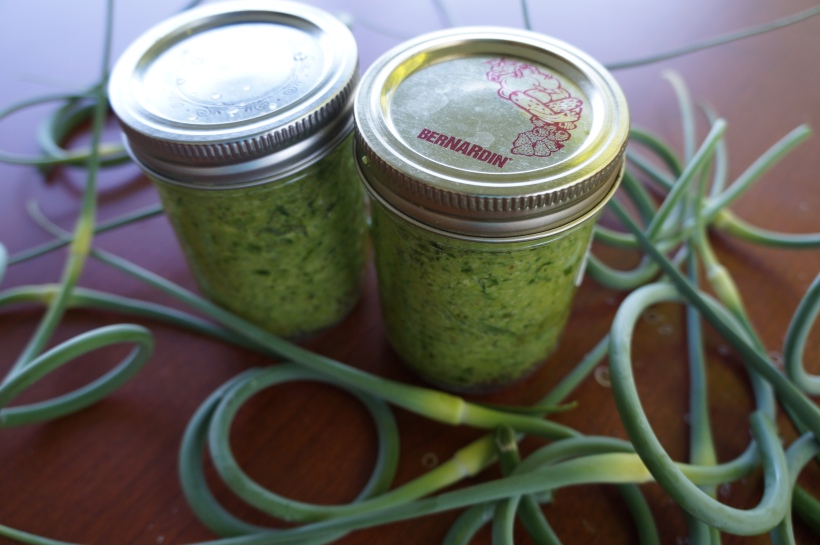Our lawn is covered mostly with four plants. Grass, clover and dandelions I am well familiar with – but the fourth seemed barely worthy of a name. It is neither beautiful, nor so ugly that you need to get rid of it – it just is. I recently read about this plant which indeed does have a name, plantain or plantago mayor and I became intrigued by its many uses, nutritional and medicinal. All its parts are edible, and while I haven’t found any ripe seed pods yet this year, I have been using the young, light green leaves raw and cooked.
Where to find them: Lawns, fields, roads, gravel, cracks in pathways. It was brought to North America by colonizers and was referred to as “white man’s footprint” as it was found growing in all the European settlements where the land had been disturbed.
Identification: The plant is made of a rosette of oval leaves. The veins begin at the base – the central one being straight and extending through the full length of the leaf. The remaining veins are curved along the line of the shape of the leaf. The flower is a stiff rod, at first green and then turning brown which sticks straight up from the centre of the plant.
Uses: Young leaves can be eaten raw, while the older ones should be cooked until tender. The leaves which have antibacterial and astringent properties can be used as a poultice to apply to stings and wounds to reduce pain and prevent infection. Seed pods can be cooked much like asparagus, and the seeds are used as a substitute for psyllium. It is also a valuable weed in your garden as it breaks up hard soil and holds loose soil together to prevent erosion.
Nutritional Value: Rich in iron and vitamins A and C.
Recipes using Plantago Major
The easiest comparison of this plant with something familiar would be spinach, although the leaves are tougher, more like kale. The flavour is not strong, so pairing them with seasoning, herbs, garlic, lemon, fish sauce, soya sauce and other flavourings all work well.
I first tried steaming them in oil and a splash of water with garlic which I then combined with omelettes and pasta or just served as a side dish.
I also made a smoothie, using 1 cup of young raw plantain leaves, 2 sprigs of mint, a little honey, 2 cups of almond milk and a banana and an apple. Pureed in the blender and chilled it made a delicious healthful drink, even if the appearance was less than stellar.
Now that scapes are in season, I decided to augment my scape pesto with some plantain. This recipe can be frozen for several months, so I tend to make a good batch of it – by a good batch I mean enough for one meal plus two jars.
Scape and Plantain Pesto
1/2 lb scapes
one handful of young plantain leaves
1/2 cups olive oil
1/2 cups walnut pieces
Blend all the ingredients in a food processor until almost smooth. Salt to taste or parmesan cheese can be added, but I usually add those when I serve them. This pesto is excellent with pasta, spread on bread or crackers, or served with fish.









June 26, 2014 at 8:48 pm
So interesting! I had no idea this plant was edible. I don’t have a real front yard, but my neighbor’s front yard is overgrown with these plantain plants. I’ll have to ask and pick some to try myself!
LikeLike
June 26, 2014 at 8:52 pm
I was surprised to find they were edible too. And all you need is a little added to your regular recipes to increase the nutrition level. Also, am going to start using it on insect bites. Wish I had known about it when I got two bee stings in my mouth (the bees were in my bottle of beer, and was that painful!).
LikeLike
June 26, 2014 at 8:53 pm
Wait, what? Ouch! Hope you are better, and thank you for that tip!
LikeLike
June 28, 2014 at 3:36 am
Oh my god that’s so scary! I hope you’re okay
LikeLike
June 27, 2014 at 1:04 am
Wow, how interesting. When I just saw the preview post in my wp reader, I thought “oh my gosh, she even grows plantains (as in the tropical banana type fruits)!!!” I had no idea there was a plant with the same name. They look a little bit like basil, at least the leaves do. I just love your way of eating and cooking!
LikeLike
June 27, 2014 at 1:10 am
Thanks Sue. I wish I did have the other kind of plantain, but in this climate we can’t be too choosy. They are a lot tougher than basil, not any notable aroma like basil, but they do taste green, are packed with good stuff and they are easy to grow.
LikeLike
June 27, 2014 at 5:09 pm
I didn’t know their name… we’ve been using these leaves to combat the itchy rash caused by stinging nettle. I hadn’t thought about using this plant for bug bites, but I’m going now, as the mosquitos are starting to show themselves!
LikeLike
June 27, 2014 at 5:11 pm
You can preserve them in oil too – six weeks infusion and then strain and use it as a remedy for bites, stings etc. as you would with any antiseptic ointment. I plan to do this soon. You can also use the oil for cooking.
LikeLike
June 27, 2014 at 5:13 pm
What a great idea. I’m going to try this! Thanks 🙂
LikeLike
June 27, 2014 at 9:40 pm
Cool! I felt quite brave trying lambs quarter last night but now I see more weeding/harvesting is still to come.
LikeLike
June 27, 2014 at 9:42 pm
Good to hear. There should probably be a word to cover weeding and harvesting together. I’ll work on that!
LikeLike
June 28, 2014 at 1:26 am
Hilda, I sure do learn lots of plants names from you. 🙂
LikeLike
June 28, 2014 at 1:44 am
Thanks Fae. I like this one because it does have so many uses. I’m planning to make an infusion with oil for insect bites (this is major bite season here) and other nasties. And if I don’t need it, can always use it for cooking.
LikeLike
June 28, 2014 at 3:38 am
I’ve been wondering about these mysterious ‘plantains’ my forager friends have been talking about. Thanks for the great info!
LikeLike
June 28, 2014 at 1:04 pm
Hilda, there is always something new to learn on your site. I always keep an eye out in my walks to see if I recognize something I can try. Thank you for sharing your knowledge.
LikeLike
June 29, 2014 at 8:00 pm
wow! in my childhood we use that one to stop bleeding in case you fall and damage your knee. it really helps
LikeLike
June 30, 2014 at 3:52 pm
In Russian it’s called “поддорожник” which means “under the road” but kind of hard to translate in English. I think it’s because it often grows along the road.
LikeLike
June 30, 2014 at 4:04 pm
I’m sure that’s why it has that name, although there must be a botanical name too. Thanks for telling me though because I am always trying to build my Russian vocabulary. I’ll wow someone with that one!
LikeLike
July 11, 2014 at 7:13 pm
So cool! I’ve been using it for skincare, but I will have to add it to recipes now as well. The pesto looks especially good!
LikeLike
July 11, 2014 at 7:56 pm
I just started using it for insect bites and am impressed at how quickly it takes effect. Do you have any other uses for it as skincare I should know about it? Since I am quite new to it, am always interested in learning more.
LikeLike
Pingback: The Greatest Scapes | Along the Grapevine
July 9, 2015 at 1:23 pm
Great post, Hilda! We have two varieties of plantain growing here. The “regular” kind of plantain like the kind in your post and Lance leaf plantain – plantago lanceolata. It looks like giant ablades of grass. As near as I can figure, they both work the same way.
Last Sunday, on our way out to church, my daughter literally walked into a wasp, which stung her on the hand. I pulled some plantain, chewed it, and then put the poltice on her hand. The pain was gone quickly, and by the time church was over, you couldn’t even tell where she had been stung. It really works!
I have an oil infusion in the works right now.
LikeLike
July 9, 2015 at 6:04 pm
Thanks Connie.
LikeLiked by 1 person
Pingback: From Lawn to Table | Along the Grapevine
Pingback: (The Northwest Forager) Ep. 9 Common Plantain - Medical Weeds